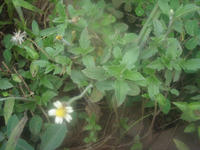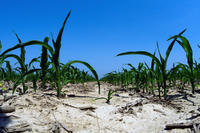-
Silica particles purify water by acting as oil magnets
Engineers develop an innovative method designed to purify water through the rapid removal of oily pollutants. The technology involves the deployment of surface engineered silica particles, which act as oil magnets in water, adsorbing oil, yet repelling water.
-
-
Arsenic contamination in food and water supplies
After virtually eliminating arsenic as a useful tool for homicide, science now faces challenges in doing the same for natural sources of this fabled old “inheritance powder” that contaminates water supplies and food, threatening more than thirty-five million people worldwide.
-
-
Using plants for herbal defluoridation of drinking water

A filtration system based on a medicinal herb can quickly and easily remove “fluoride” from drinking water, say researchers in India. The technology uses parts of the plant Tridax procumbens as a biocarbon filter for the ion.
-
-
Better management of water resources in Canada
Canadian agriculture is faced with great opportunities, but also challenged by water — related risks and uncertainties. An expert panel convened by the Council of Canadian Academies has found that water and land resources in Canada can be more sustainably managed by developing forward — thinking policies and effective land and water management strategies, adopting effective governance mechanisms, and harnessing technological advancements.
-
-
Water managers can now consult new U.S. water evaporation maps
The amount of water available for people and ecosystems is the amount of annual precipitation — that is, snow or rain — minus the amount of annual evapotranspiration. Evapotranspiration itself is the amount of water lost to the atmosphere from the ground surface. Scientists map the long-term U.S. evapotranspiration rates for the first time.
-
-
The sobering reality of water security
Agriculture is one of the world’s most insatiable consumers of water. Yet, it is facing growing competition for water from cities, industry, and recreation at a time when demand for food is rising, and water is expected to become increasingly scarce.
-
-
Novel technology to tackle global water challenges

The University of Alberta will unveil new technologies its researchers and students will use to replace inadequate water purification and monitoring equipment in remote communities in Canada and India.
-
-
The ground is key to cleaner environment, water
While many people recognize that clean water and air are signs of a healthy ecosystem, most do not realize that a critical part of the environment is right beneath their feet. The ground plays an important role in maintaining a clean environment by serving as a natural water filtration and purification system.
-
-
Sewage lagoons remove most pharmaceuticals from wastewater

Despite these advances made under the Clean Water Act, sewage remains a major source of pharmaceuticals and personal care products (PPCPs) and naturally occurring hormones found in the environment. New research shows the effectiveness of rural lagoon systems at removing these compounds from wastewater.
-
-
The Middle East rapidly losing fresh water

A new study using data from a pair of gravity-measuring NASA satellites finds that large parts of the arid Middle East region lost freshwater reserves rapidly during the past decade. Scientists found during a seven-year period beginning in 2003 that parts of Turkey, Syria, Iraq, and Iran along the Tigris and Euphrates river basins lost 117 million acre feet (144 cubic kilometers) of total stored freshwater. That is almost the amount of water in the Dead Sea. The researchers attribute about 60 percent of the loss to pumping of groundwater from underground reservoirs.
-
-
The historical probability of drought

Droughts can severely limit crop growth, causing yearly losses of around $8 billion in the United States. It may be possible, however, to minimize those losses if farmers can synchronize the growth of crops with periods of time when drought is less likely to occur. Researchers are working to create a reliable “calendar” of seasonal drought patterns that could help farmers optimize crop production by avoiding days prone to drought.
-
-
Maryland counties debate funding stormwater drainage management
A new tax aimed at property owners could finance the first set of improvements of the drainage works in Salisbury, Maryland since the original system was laid almost a century ago. City leaders have been arguing since 2009 over dedicating a source of funding to stormwater management, when an environmental panel recommended it. In the past, funding for projects like this has been hard to find as other priorities were deemed more important.
-
-
Large amounts of antibacterial agent used in soaps found in freshwater lakes
When people wash their hands with antibacterial soap, most do not think about where the chemicals contained in that soap end up. A new study determined that the common antibacterial agent, called triclosan, used in soaps and many other products, is found in increasing amounts in several Minnesota freshwater lakes.
-
-
Global demand for food and energy is growing, and so does land and water “grabbing”

As world food and energy demands grow, nations and some corporations increasingly are looking to acquire quality agricultural land for food production. Some nations are gaining land by buying up property — and accompanying water resources — in other, generally less wealthy countries.
-
-
Students develop low-cost water filtering system for African nation
Every year, 3.4 million people die from lack of access to fresh water globally; in East Africa, daily routines include women venturing miles to secure fresh water and bearing the heavy weight of water containers to secure less-than-desirable water; in an effort to bring fresh water to rural Kenyans, Penn State’s School of International Affairs (SIA) students have developed a ceramic water filtration system for parts of the sub Saharan African nation
-
More headlines
The long view
Water Wars: A Historic Agreement Between Mexico and US Is Ramping Up Border Tension
As climate change drives rising temperatures and changes in rainfall, Mexico and the US are in the middle of a conflict over water, putting an additional strain on their relationship. Partly due to constant droughts, Mexico has struggled to maintain its water deliveries for much of the last 25 years, deliveries to which it is obligated by a 1944 water-sharing agreement between the two countries.
